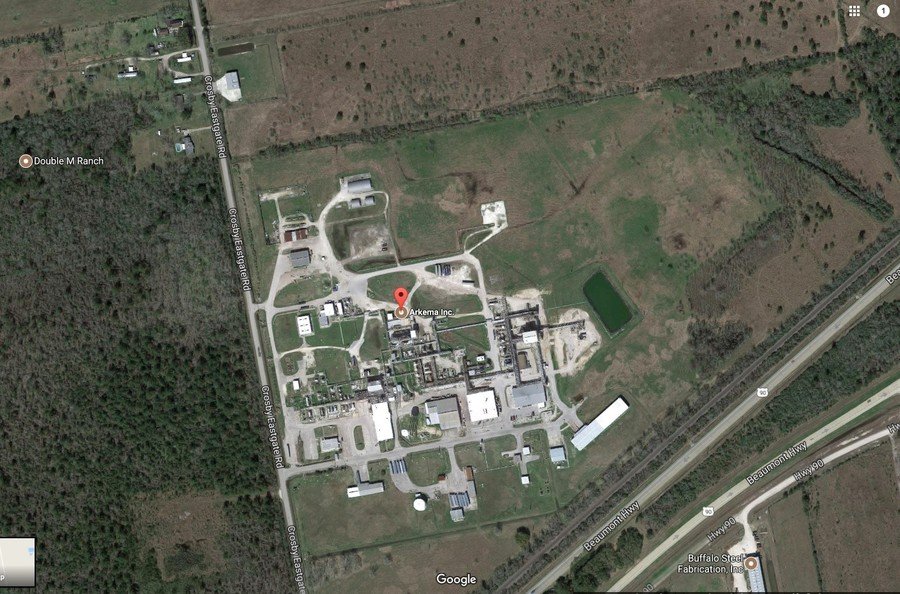Full threat posed by Arkema plant disaster still unknown

Two explosions were reported Thursday at the Arkema chemical plant in Crosby, Texas with the company saying more expected are to follow. The extent of the risk posed by Texas’ petrochemical industry in the wake of Harvey is unknown.
But according to a 2014 worst-case scenario plan submitted to the Environmental Protection Agency in the event of explosion at Arkema, up to 1.1 million people over 23 square miles (59.5km squared) could be affected, AP reported.
The worst-case scenario plan was created under the assumption of normal weather conditions, and doesn’t account for the current flooding situation left in the wake of Hurricane Harvey.
Residents who had not evacuated from the surrounding area have been told by authorities to stay indoors and turn off air-conditioning.
Arkema is a chemicals company that creates coating solutions, industrial chemicals and products used in PVC, polyester and resins. Its Crosby plant contains high amounts of sulfur dioxide, a toxic chemical, and methylpropene, a flammable gas.
The explosions at the Crosby plant occurred after flooding overwhelmed the power supplies, causing refrigeration units to stop working. This resulted in some of Arkema’s “organic peroxides” igniting, the company said in a statement.
Six additional explosions are expected, as organic peroxide is stored in eight containers around the plant. Organic peroxides are categorized under two different hazard symbols by the Occupational Safety and Health Administration, ‘fire’ and ‘exploding bomb.’
“We want local residents to be aware that product is stored in multiple locations on the site, and a threat of additional explosion remains,” Arkema said.
Nous sommes à 3km de l'usine Arkema de #Crosby, au vent des fumées. Pas d'irritation mais une odeur "chimique" prégnante. @BFMTVpic.twitter.com/BQM2xAVaDN
— Patrick Sauce (@SaucePatrick) August 31, 2017
In 2014, the company said it housed as much as half a million pounds of cumene hydroperoxide at its Crosby plant, which explodes when combined with a number of other chemicals and can catch fire or explode if it comes into contact with electric current or excessive heat.
The company told Chronicle reporters in 2016 that since then, it had “significantly” reduced its maximum amount of cumene hydroperoxide at the plant.
We are two miles away and Crosby fire says we must leave. Will update on @KPRC2 soon pic.twitter.com/3sn5OH5enz
— Haley Hernandez (@HaleyKPRC) August 31, 2017
It is difficult to know the extent of the threat posed by the Arkema plant emergency, due to uncertainty about exactly which chemicals are housed at the plant.
This is, in part, due to Texas’ circumvention of federal law that mandates disclosure.
Following the 1986 Bhopal chemical leak in India, states have been required under the Emergency Planning and Community Right-to-Know Act to produce chemical inventories. This is done through mandated Tier II reports.
Texas allows companies to withhold inventories from the public if they believe such information could be useful to terrorists, the Chronicle reports.
Arkema North America CEO Rich Rowe said he would not release the company’s risk management plan or a chemical inventory on Wednesday, the Chronicle reports.
Arkema was identified as one of the highest-risk sites in the Texas petrochemical hub, a 2016 analysis by the O’Connor Process Safety Center and the Houston Chronicle found. It determined risk based on the amount of known chemicals on site, and its proximity to the public.
#ExxonMobil is among companies to report incidents of emissions released at refineries due to #HurricaneHarveyhttps://t.co/osp5Y1i1Yr
— RT America (@RT_America) August 30, 2017
A lack of clarity over which chemicals are contained within the plant poses an ominous threat. Firefighters need to know which materials are present at a plant to properly fight a fire or explosion. For example, fighting fires with water could potentially cause further explosions or toxic releases.
As part of its 2016 investigation, the Chronicle reported Houston’s fire department “has no idea where most hazardous chemicals are.”
Retired firefighter and fire inspector Chris Cato told the Chronicle that most hazardous materials facilities in Houston operate illegally."That's the thing that keeps me up at night," he said.
On Wednesday, the company detailed the expected fire could “resemble a large gasoline fire” and that it would be “explosive and intense."
READ MORE: More fires, explosions expected at flooded chemical plant near Houston
The company did say smoke from the fires could contain products that would cause respiratory irritation, nausea or dizziness. “There are other flammable raw materials on site that could also catch fire,” Arkema said in its statement.
“There is a small possibility that the organic peroxide will release into the flood waters but will not ignite and burn,” the company added.
However, Harris County Fire Marshal spokeswoman Rachel Moreno said because the area is surrounded by water, “we don’t anticipate the fire going anywhere.”

An evacuation order for residents living 1.5 miles around the plant was announced by Harris County on Tuesday.
NPR reports the EPA estimates nearly 4,000 people live within a 3-mile radius of the plant. It’s unknown exactly how many remain within the 1.5 mile evacuation radius.
Arkema says the plant "is in a rural area with no hospitals, schools, correctional facilities or recreational areas or industrial/commercial areas in the vicinity."












